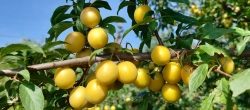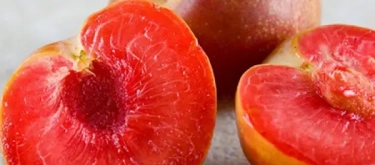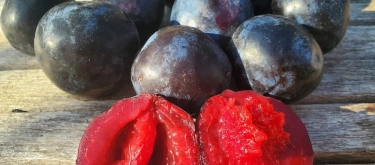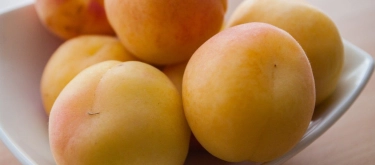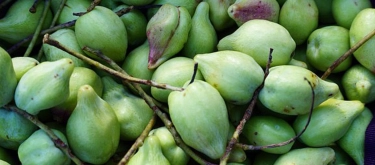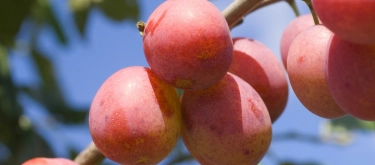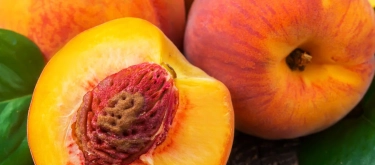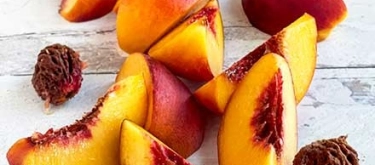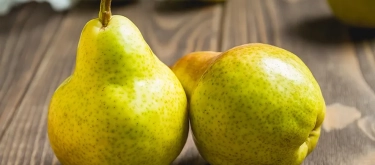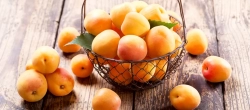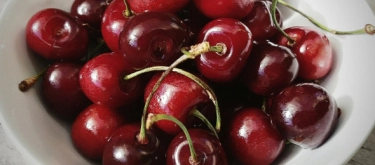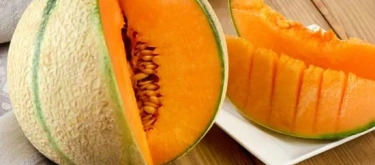Plum: Taste Profile, Aroma, Benefits and Health Risks
The plum (Prunus domestica) is a juicy, flavorful stone fruit celebrated for its vibrant sweetness and culinary versatility. Originating from Central Asia, plums have been cultivated for thousands of years across Asia, Europe, and North America. Consumed fresh, dried (prunes), or cooked, plums play essential roles in global cuisines, offering distinctive flavor profiles and nutritional value that have made them universally popular.
Plums are suitable for vegetarian, vegan, and gluten-free diets. They rarely cause allergic reactions, though some individuals sensitive to birch pollen or related fruits (Oral Allergy Syndrome) may experience mild oral symptoms. Excessive consumption may lead to digestive discomfort due to their fiber and natural sugar content.
What does Plum taste like?

Complete Sensory Description
Taste
Plums offer a balance of sweetness, tartness, and subtle aromatic complexity. The primary flavor is mildly sweet to richly honeyed, often balanced by refreshing acidity. Dark-skinned varieties typically showcase deeper, sweeter, berry-like flavors, while yellow or green-skinned varieties tend to offer a lighter, brighter sweetness with pronounced tartness. Underlying flavors can include subtle floral, almond-like, or spice-driven notes, especially evident near the stone, enhancing the overall tasting experience.
Aroma
Ripe plums exude a gentle, sweet fragrance characterized by fruity, floral, and slightly spicy undertones. Key aromatic compounds, such as benzaldehyde and various esters, contribute to their subtle almond-like, fruity, and floral aromas. Aromatic intensity increases significantly with ripeness, making fully ripe plums particularly enticing.
Texture
Plum flesh texture varies between varieties, generally tender, succulent, and juicy. Some varieties exhibit firmer, slightly crunchy flesh (common in early-season varieties), while others become meltingly soft and lushly juicy when fully ripe. Plum skin, thin yet slightly firm, provides a gentle textural contrast, easily chewable yet offering a pleasant bite.
Appearance
Plums showcase diverse colors and shapes, typically round or oval, with smooth, glossy skin. Skin colors range from deep purple, dark red, or blue-black, to vibrant yellow, amber, or green, depending on variety. The flesh often contrasts beautifully, ranging from pale yellow to vivid red or amber, enhancing their visual appeal in fresh and culinary preparations.
In-depth Flavor Analysis
Plum's characteristic sweetness derives from fructose, glucose, and sucrose, sugars whose concentrations vary considerably by cultivar and ripeness. The balanced tartness, predominantly from malic acid with minor citric acid contributions, provides brightness and complexity, preventing sweetness from becoming cloying.
Key aromatic compounds shaping plum flavor include esters (ethyl acetate, hexyl acetate), benzaldehyde, and lactones. Benzaldehyde, concentrated particularly near the stone, contributes almond-like notes, providing subtle complexity. Esters like ethyl butanoate deliver fruity, berry-like nuances, while lactones lend mild sweetness and creamy, fruity characteristics.
Environmental and cultivation conditions significantly impact flavor. Warm, sunny climates produce plums with higher sugar content, reduced acidity, and enhanced sweetness. Cooler climates yield plums with higher acidity, lower sugars, and pronounced aromatic complexity, ideal for culinary versatility.
Ripeness dramatically affects plum flavors; underripe plums taste sharply acidic and mildly astringent due to tannins. Optimal ripening balances sweetness, tartness, and aromatic complexity, providing maximum enjoyment.
Varieties and Culinary Applications
European Plums (Prune plums)
- Sweet, firm flesh, ideal fresh, for drying (prunes), baking, preserves, jams, sauces, and desserts like plum tarts.
Japanese Plums
- Juicy, sweet-tart balance, versatile fresh or in culinary preparations—ideal for sauces, jams, preserves, salads, or desserts.
Greengage Plums
- Extremely sweet, richly aromatic, excellent fresh, in desserts, gourmet dishes, preserves, and sauces.
Mirabelle Plums
- Small, sweet, aromatic, primarily used fresh, in preserves, brandy, liqueurs, or desserts.
Culinary Versatility
Plums shine in numerous dishes:
- Fresh consumption: Ideal snacks, fruit platters, salads, or accompaniments to cheese.
- Desserts & Pastries: Plum cakes, tarts, crisps, cobblers, and puddings.
- Preserves and Sauces: Plum jam, chutney, sauces for meats (duck, pork), or glazes.
- Beverages: Plum juices, smoothies, liqueurs, and infused spirits.
- Savory Pairings: Complements roasted meats, cheeses, and savory sauces.
Selection and Storage
Selecting Quality Plums
- Choose plums firm yet yielding slightly under gentle pressure, with smooth, unblemished skin and pleasant fragrance.
- Avoid plums overly firm, shriveled, bruised, or with visible spoilage.
Storage Recommendations
- Ripen plums at room temperature. Refrigerate ripe plums (2–4°C / 35–39°F) to preserve freshness for up to one week.
- Handle gently to prevent bruising.
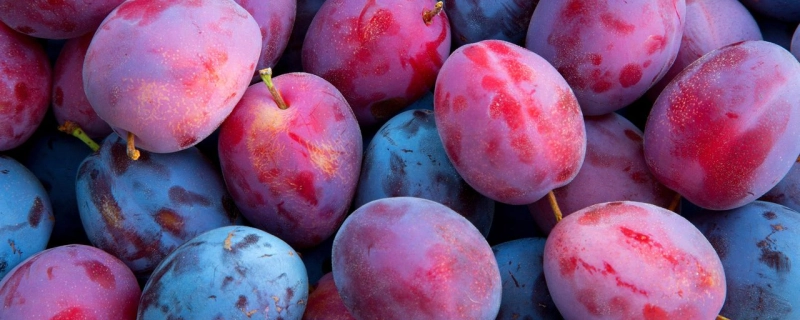
Nutritional Insights
-
Vitamin C & Antioxidants:
Contains beneficial amounts of vitamin C, boosting immune function, collagen synthesis, and antioxidant protection against oxidative stress. -
Dietary Fiber:
Rich dietary fiber aids digestion, promotes gut health, and helps regulate cholesterol levels. -
Potassium & Minerals:
Provides potassium and magnesium, supporting cardiovascular health, fluid balance, and nerve function. -
Phenolic Compounds:
Rich in polyphenols, flavonoids, and anthocyanins (particularly dark-skinned varieties), offering anti-inflammatory and antioxidant properties beneficial for overall health.
Expert Insights & Culinary Tips
-
Flavor Pairings:
Plums pair excellently with cinnamon, cardamom, ginger, almond, vanilla, honey, chocolate, meats (pork, duck, lamb), cheeses (blue cheese, goat cheese), and wines (Riesling, Pinot Noir). -
Cooking Techniques:
Cooking or roasting plums enhances natural sweetness, caramelizing sugars, deepening flavors, and creating rich sauces or desserts. -
Balancing Tartness:
Use sugar, honey, or complementary sweet ingredients to balance tartness effectively, particularly with underripe or tart varieties.
Interesting and Curious Facts
- Plums were among the first fruits domesticated by humans, cultivated thousands of years ago in ancient cultures, notably China and the Mediterranean.
- Dried plums (prunes) are historically revered for digestive health properties, traditionally used medicinally for their fiber-rich benefits.
- Plum blossoms symbolize renewal and resilience in East Asian cultures, commonly featured in art, poetry, and seasonal celebrations.
Harm and Dietary Considerations
-
Oral Allergy Syndrome:
Individuals allergic to birch pollen or similar allergens may experience mild reactions to raw plums. -
Digestive Issues:
High fiber content can cause gastrointestinal discomfort, including bloating or diarrhea, if consumed excessively. -
Oxalate Content:
Contains moderate oxalate levels; individuals prone to kidney stones or on low-oxalate diets should consume moderately.
Religious Dietary Considerations
Plums are universally permissible across major religions:
- Islam: Permissible (Halal).
- Judaism: Permissible (Kosher, Parve).
- Hinduism & Buddhism: Widely permissible; commonly used in religious ceremonies and offerings.
- Christianity & other global religions: No known dietary restrictions.
Final Thoughts & Sensory Journey
Plums captivate with their vibrant sweetness, gentle acidity, and aromatic complexity. Whether enjoyed fresh, dried, or cooked into dishes both sweet and savory, plums enrich culinary experiences, offering nutritional value and timeless culinary enjoyment worldwide.
Resources
- McGee, H. (2004). On Food and Cooking: The Science and Lore of the Kitchen. Scribner.
- USDA FoodData Central (2023). Plums: Nutritional Composition and Culinary Insights.
- Food and Agriculture Organization (FAO). (2021). Stone Fruits: Cultivation, Nutrition, and Culinary Uses.
